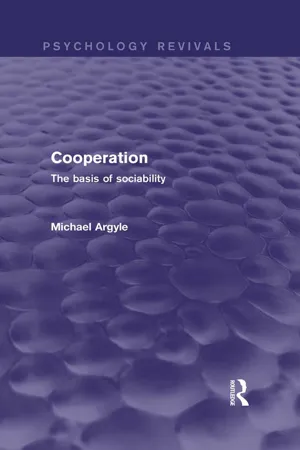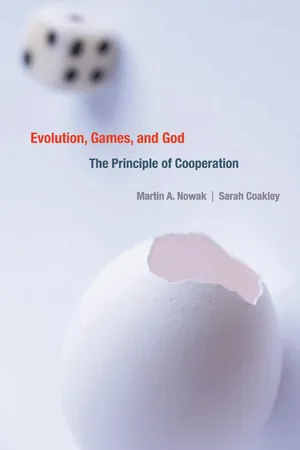Cooperation in Animals
Cooperation in animals refers to the behavior where individuals work together for mutual benefit. This can involve activities such as hunting, raising offspring, or defending territory. Cooperative behavior can enhance the survival and reproductive success of individuals within a group, and it is observed in various species across the animal kingdom.
4 Key excerpts on "Cooperation in Animals"
- eBook - ePub
- Nicholas B. Davies, John R. Krebs, Stuart A. West(Authors)
- 2012(Publication Date)
- Wiley-Blackwell(Publisher)
...The latter clause is added to exclude behaviours which merely provide a one-way by-product to others (West et al., 2007a). For example, when an elephant produces dung, this is beneficial to a dung beetle that comes along and uses that dung but it is not useful to think of this as cooperation, as the elephant produces dung for purely selfish reasons (emptying waste). The production of dung would only qualify as cooperation if a higher level of dung production had been favoured, because of the benefits to dung beetles. The definition of cooperation therefore includes all altruistic (−/+) and some mutually beneficial (+/+) behaviours (Box 11.1). A behaviour is cooperative if it benefits another individual and has been selected for because of that benefit Cooperation can take many different forms in different organisms (Fig. 12.1). In cooperative breeding vertebrates, such as meerkats or Florida scrub jays, individuals often live in groups that include the dominant pair, which do most of the breeding, and the subordinates who help care for the young (Hatchwell, 2009; Clutton-Brock, 2009c). The subordinates can be either individuals who have not dispersed from their natal group, or immigrants who have joined a group. In birds, the subordinates are often termed ‘helpers at the nest’. Cooperative behaviours in vertebrates include feeding and protecting the young or other members of a group. Similar forms of help occur in some insect species, reaching their pinnacle in the eusocial insects (e.g. ants, bees, wasps and termites) where the subordinates become sterile workers and give up all chances of breeding independently. Fig. 12.1 Cooperation. (a) Cells of the algae Volvox carteri weismannia form cooperative spherical multicellular groups, which contain up to 8000 small somatic cells arranged at the periphery and a handful of much larger reproductive (germ) cells...
- eBook - ePub
Neuroeconomics of Prosocial Behavior
The Compassionate Egoist
- Carolyn Declerck, Christophe Boone(Authors)
- 2015(Publication Date)
- Academic Press(Publisher)
...However, there is substantial variation in the processes by which mutualism can be achieved in nature, ranging from simple coordination to costly cooperation. At the simplest level, mutualistic interactions between species emerge from mimicking behavior and simple operant conditioning whereby each animal is rewarded for synchronizing its behavior with another animal (Brosnan & Bshary, 2010 ; Bshary, Hohner, Ait-El-Djoudi, & Fricke, 2006). This is likely how mutualistic relations between plants and bacteria, or coordinated actions of coral reef fish in pursuit of prey, become established. In human societies, market exchanges between buyers and sellers are a good example, as these sorts of interactions are likely to confer net benefits to both parties. In comparison to coordination, cooperation is cognitively much more complex for at least two reasons. First, collaborative efforts (e.g., during cooperative hunting of social mammals) require complementarity (keeping track of each other’s actions) and working memory to keep track of who is reciprocating who. Second, subsequent sharing the common good (e.g., the prey) may set the stage for cheating or free riding, challenging the accrual of benefits for those who are not tempted by greed and are playing it straight. Thus, while cooperation is a process intended to yield a mutually beneficial outcome, it can turn out to be costly when betrayal becomes possible. When two students collaborate on a task and deliver homework that is better than either one of them could have accomplished alone, their mutual cooperation has created synergy, but each of them took the risk that the other one could have been a poor collaborator or disloyal at the end. Because it can be costly, and in contrast to other eusocial species where cooperation evolved to be a genetically preprogrammed part of behavior, large-scale cooperation in humans relies much on cognition...
- eBook - ePub
Cooperation (Psychology Revivals)
The basis of sociability
- Michael Argyle(Author)
- 2013(Publication Date)
- Routledge(Publisher)
...Birds give alarm calls, at risk to themselves, others respond by ‘mobbing’ the predator. Monkeys live together in large groups, collaborating over defence, nestbuilding and eating. Animals display a lot of helpful and apparently altruistic behaviour. They collaborate in sexual behaviour and looking after infants, to continue the species. They have the capacity to communicate by facial expressions, vocalisations, and in other ways. The bodily equipment for all this behaviour – faces, voices and sexual organs – is obviously innate, so to a large extent are the related behaviour patterns, especially in lower animals. The evolutionary explanation of all this is that such cooperation is essential for the survival of individual and species. The origins of help and altruism, and to a lesser extent cooperation, have been something of a theoretical problem. An early theory was that helpful and cooperative groups were at an advantage for survival. However, it was argued that, in a helpful group, selfish individuals and their descendants would do best, so that unrestricted helpfulness is not an ‘evolutionarly stable system’. Two quite different evolutionary models have now been put forward: the idea of ‘inclusive fitness’ – that individuals act to promote the survival of their genes, and hence help and cooperate with others who share their genes, that is their kin. The second model is of reciprocal altruism. Both will be explored in the next chapter. Helping behaviour and altruism Social psychologists meanwhile became more interested in helping than in cooperation. This was partly because helping behaviour posed a theoretical problem to those who believed that all behaviour was motivated by drive-reduction. Part of the solution was found to lie in empathy, the capacity to share another's emotional state, and especially states of distress. We shall see later that empathy is equally important for cooperation...
- eBook - ePub
Evolution, Games, and God
The Principle of Cooperation
- Martin A. Nowak, Sarah Coakley(Authors)
- 2013(Publication Date)
- Harvard University Press(Publisher)
...New levels of organization evolve when the competing units on the lower level begin to cooperate. Cooperation allows specialization and thereby promotes biological diversity. Cooperation is the secret behind the open-endedness of the evolutionary process. Perhaps the most remarkable aspect of evolution is its ability to generate cooperation in a competitive world. Thus, we might add “natural cooperation” as a third fundamental principle of evolution besides mutation and natural selection. 3 Notes 1. Supporting material for this chapter was published in Science and is online at http://www.sciencemag.org/content/suppl/2006/12/05/314.5805.1560.DC1/Nowak.SOM.pdf. 2. The details of all these arguments and their limitations are given online in the Science link in Note 1. 3. Support from the John Templeton Foundation and the NSF/NIH joint program in mathematical biology (NIH grant 1R01GM078986–01) is gratefully acknowledged. The Program for Evolutionary Dynamics at Harvard University is sponsored by Jeffrey Epstein. References Alexander, R. D. 1987. The Biology of Moral Systems. New York: Aldine de Gruyter. Axelrod, R. 1984. The Evolution of Cooperation. New York: Basic Books. Axelrod, R., and W. D. Hamilton. 1981. “The Evolution of Cooperation.” Science 211: 1390–96. Bowles, S., and H. Gintis. 2004. “The Evolution of Strong Reciprocity: Cooperation in Heterogeneous Populations.” Theoretical Population Biology 65: 17–28. Boyd, R., H. Gintis, S. Bowles, and P. J. Richerson. 2003. “The Evolution of Altruistic Punishment.” Proceedings of the National Academy of Sciences of the USA 100: 3531–35. Brandt, H., and K. Sigmund. 2004. “The Logic of Reprobation: Assessment and Action Rules for Indirect Reciprocation.” Journal of Theoretical Biology 231: 475–86. Bshary, R., and A. S. Grutter. 2006. “Image Scoring Causes Cooperation in a Cleaning Mutualism.” Nature 441: 975–78. Camerer, C. F., and E. Fehr. 2006...



